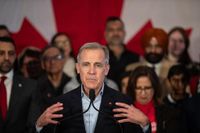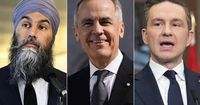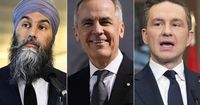OTTAWA — Canadians will vote on April 28 in a snap spring election to be called Sunday as newcomer Liberal Leader Mark Carney seeks his own governing mandate, and a fourth term for the Liberal party. Carney, who will have been prime minister for 10 days when he returns to Rideau Hall, will ask Gov. Gen. Mary Simon to dissolve Parliament and issue election writs for Canada's 45th general federal election.
The Liberal party confirmed the move on social media late Saturday, March 22, 2025. Carney will run to represent the suburban Ottawa riding of Nepean, previously represented by Liberal MP Chandra Arya, who was disqualified as unfit in the leadership race to replace Justin Trudeau. Arya's candidacy for re-election was rejected by the party.
Sources confirmed that voters will cast a ballot on Monday, April 28, 2025, marking the end of what will be a 37-day campaign, one day longer than the minimum required by law. The number of federal ridings increases to 343 from 338 due to the redrawing of electoral boundaries. The election unfolds as U.S. President Donald Trump’s tariff war ramped up, disrupting global markets, Canadian industries, and jobs.
Carney stated, “Canadians are going to decide who their next government is going to be.” He stressed at a Friday news conference that he believes in a robust election campaign where Canadians would make the right choice without the influence of any foreign power.
In light of the election, all political parties are reshaping their pitches to illustrate that their platforms and leaders are best equipped to handle the challenges of the upcoming four years. Trump looms large over this campaign and has attempted to use the Canadian election to his advantage, having stated, “It would be great if Canada were the 51st American state.”
In a recent whirlwind of campaign activities, Carney has responded to the challenges posed by the Conservative Leader Pierre Poilievre, who seeks re-election in the Ottawa-area riding of Carleton amidst a backdrop of emerging Canadian pride and unity. Poilievre has attempted to redirect his messaging from criticizing the previous Liberal government to repositioning his platform against a Liberal party led by Carney.
In contrast, the NDP and the Greens find themselves fighting for political air time and relevance, with rising public interest pointing to a close race between the two major parties. NDP Leader Jagmeet Singh has been critical of Carney's intentions, declaring, “Nothing is safe when (Carney) has proposed cuts to the operating budget,” referencing the potential for cuts to essential programs like healthcare and dental care.
As of May 2025, all eligible Canadians will be able to apply for the Liberal party's cornerstone dental care program, a venture initiated by the government for seniors in December 2023 and progressed subsequently to include families and children.
The campaign findings show that while Carney's leadership has sparked renewed interest among Liberal supporters, there remains a perceived fragility in their voter base, as polling suggests that a significant percentage of Liberal voters express uncertainty about their voting preferences. Conservative experts point out that, despite Liberal resurgence, Conservative support remains steadfast, with figures indicating a solidified base that often bases their vote regardless of variable election circumstances.
As the campaign gears up, political analysts are closely tracking the impacts of the Liberal party's recent announcements, including measures aimed at training and employment for skilled trades. Poilievre’s strategy has prominently emphasized cutting taxes and deregulation, resonating with constituents who are fed up with rising costs of living.
The impending election is anticipated to lead to active media coverage, providing a platform for the leaders to appeal directly to voters while navigating the heightened scrutiny that characterizes Canadian elections.
Mark Carney's challenge lies in not only rallying his party's faithful but also proving to undecided voters that his experience as a former governor of the Bank of Canada equips him to lead effectively. As voters head towards the polls, they will choose not just a political party, but the visionary path they believe will safeguard the economic and social fabric of Canada as it stands against external pressures and internal challenges.








